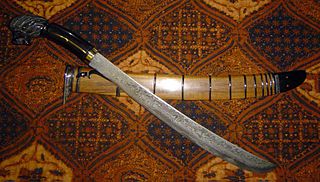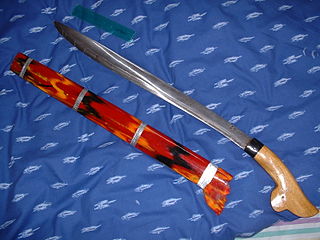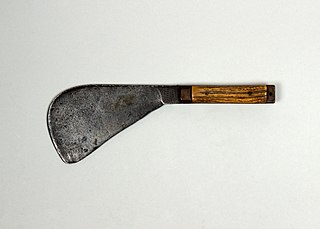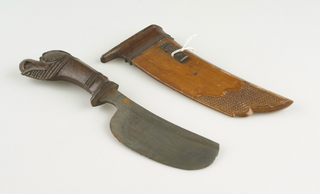
The karambit or kerambit, kurambik or karambiak is a small Indonesian curved knife resembling a claw, associated with the Minangkabau people of West Sumatra. The karambit is one of the weapons commonly used in pencak silat and Filipino martial arts.

The kris or keris is a Javanese asymmetrical dagger with a distinctive blade-patterning achieved through alternating laminations of iron and nickelous iron (pamor). The kris is famous for its distinctive wavy blade, although many have straight blades as well, and is one of the weapons commonly used in the pencak silat martial art native to Indonesia. Kris have been produced in many regions of Indonesia for centuries, but nowhere—although the island of Bali comes close—is the kris so embedded in a mutually-connected whole of ritual prescriptions and acts, ceremonies, mythical backgrounds and epic poetry as in Central Java. Within Indonesia the kris is commonly associated with Javanese culture, although other ethnicities in it and surrounding regions are familiar with the weapon as part of their cultures, such as the Balinese, Sundanese, Malay, Madurese, Banjar, Buginese, and Makassar people. The kris itself is considered as a cultural symbol of Indonesia and also neighbouring countries like Brunei, Malaysia, Philippines, Singapore, and Thailand.

A golok is a cutting tool, similar to a machete, that comes in many variations and is found throughout the Malay archipelago. It is used as an agricultural tool as well as a weapon. The word golok is used in Indonesia and Malaysia. Both in Malaysia and in Indonesia, the term is usually interchangeable with the longer and broader parang. In the Sundanese region of West Java it is known as bedog. In the Philippines, the term gulok, refers to different dagger weapons including the kris.

The parang is a type of knife used across the Malay archipelago.

A kalis is a type of Philippine sword. The kalis has a double-edged blade, which is commonly straight from the tip but wavy near the handle. Kalis exists in several variants, either with a fully straight or fully wavy blade. It is similar to the Javanese keris, but differs in that the kalis is a sword, not a dagger. It is much larger than the keris and has a straight or slightly curved hilt, making it a primarily heavy slashing weapon.

Pencak silat is an umbrella term for a class of related Indonesian martial arts. In neighbouring countries, the term usually refers to professional competitive silat. It is a full-body fighting form incorporating strikes, grappling, and throwing, in addition to weaponry. Every part of the body is used and subject to attack. Pencak silat was practiced not only for physical defense but also for psychological ends. There are hundreds of different pencak silat styles and schools which tend to focus either on strikes, joint manipulation, weaponry, or some combination thereof.

The klewang or kelewang is a category of traditional single-edged sword that can be found throughout the Malay archipelago region in Indonesia and Malaysia. Usually it is shorter than a pedang (sword) but longer than a golok (machete). There are straight bladed types, but most are curved.

The dahong palay, literally "rice leaf" in Tagalog, is a single-edged sword from the southern Tagalog provinces of the Philippines. It was originally used by farmers to clear thick grass growth. However, during the Philippine revolution of 1896, farmers from Batangas soon came to favor it for its "slashing and thrusting" feel.

Listed here are the weapons of pencak silat. The most common are the machete, staff, kris, sickle, spear, and kerambit. Because Southeast Asian society was traditionally based around agriculture, many of these weapons were originally farming tools.

Blakas or Belakas is a general name for any sort of cleaver or large knife originating from Bali, Indonesia that has a heavy rectangular blade with a straight cutting edge used for chopping. The long, rounded hilt often becomes thinner at one or both ends. The blade often has a fanciful shape and encrusted motifs. Sometimes it is made for ceremonial purposes, and also used in pairs with golok. It is a common utensil in Balinese households and is used for kitchen chores, orchard work, and in ceremonial activities.

Niabor is a curved sword from Borneo, a characteristic weapon of the Sea-Dayaks.

Jimpul is a traditional weapon of the Sea Dayak and Kenyah people from Borneo. It is often thought that the Parang Jimpul may be considered as a hybrid between the Mandau and Langgai Tinggang. The Parang Jimpul is an intermediary form between the Mandau and the Langgai Tinggang dating from c. 1870-c. 1885.

Parang Nabur is a sword that originates from Banjarmasin, South Kalimantan, Indonesia. Most of these swords were made during the Banjarmasin Sultanate period in the 19th century.

Balato is a sword that originates from Nias, an island off the west coast of North Sumatra, Indonesia.

The badik or badek is a knife or dagger developed by the Bugis and Makassar people of southern Sulawesi, Indonesia.

Sewar refers to a dagger of Indonesian origin, typically carried in a belt and used mainly in Sumatra, Indonesia. The blade is also referred to as Sewah by the Gayo people, Seiva by the Minangkabau people, Siva by the Alas people, and Siwaih by the Acehnese people.

Kabeala is a traditional weapon originating from East Sumba, Indonesia.

Wedung is a traditional large knife of the Javanese people and the Balinese people originating from Indonesia.

Ayudha katti is an indigenous weapon of war and tools to the Kodava people of Kodagu, in the state of Karnataka, India. The ayudha katti is developed from an implement used to cut through dense undergrowth. Unlike most blades, the ayudha katti is worn without a sheath.

The Bendo is a traditional bladed tool from Java, Indonesia. Betawi people would regard the Bendo as a domestic household tool and sometimes it is also called golok dapur, which means a "kitchen golok".























